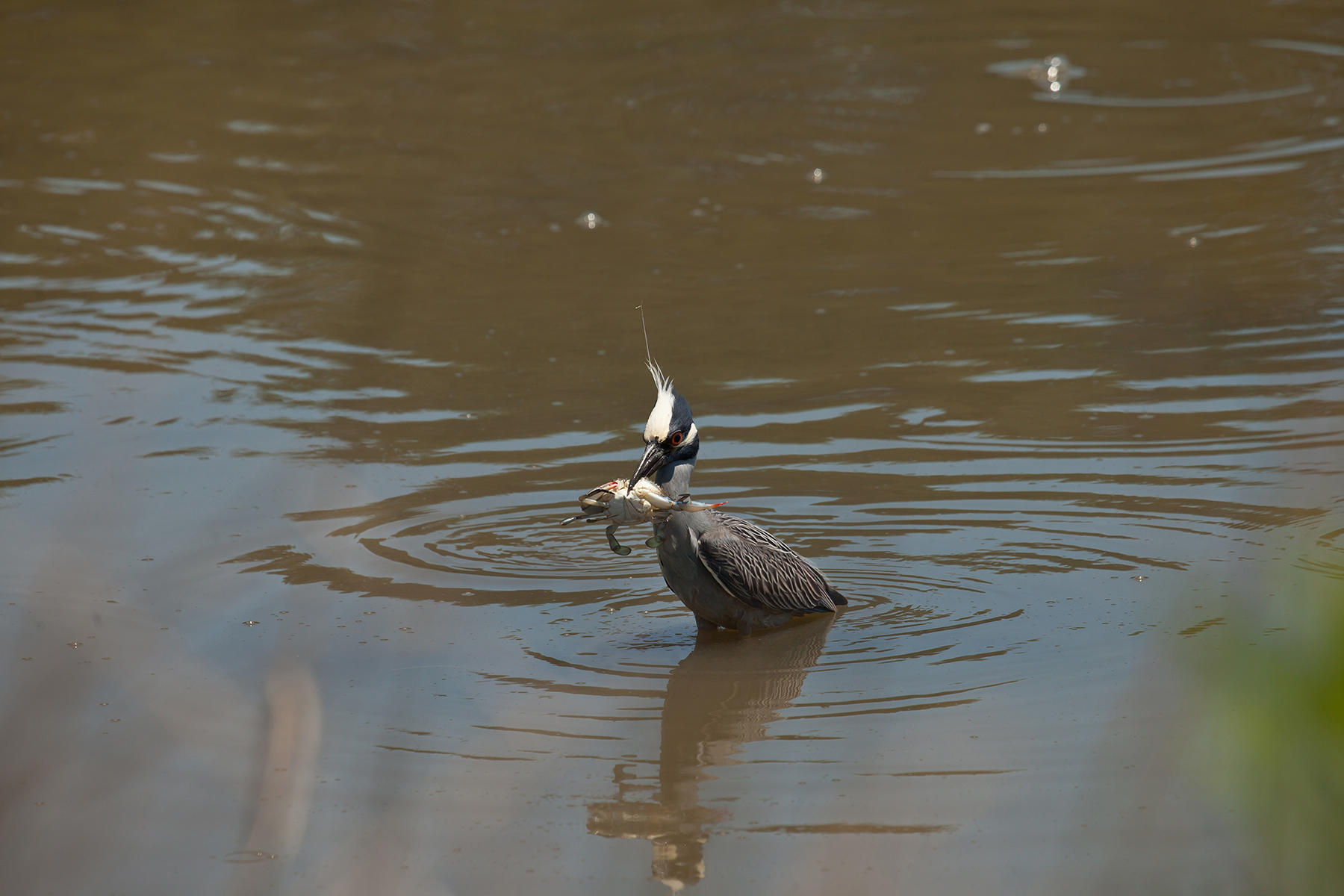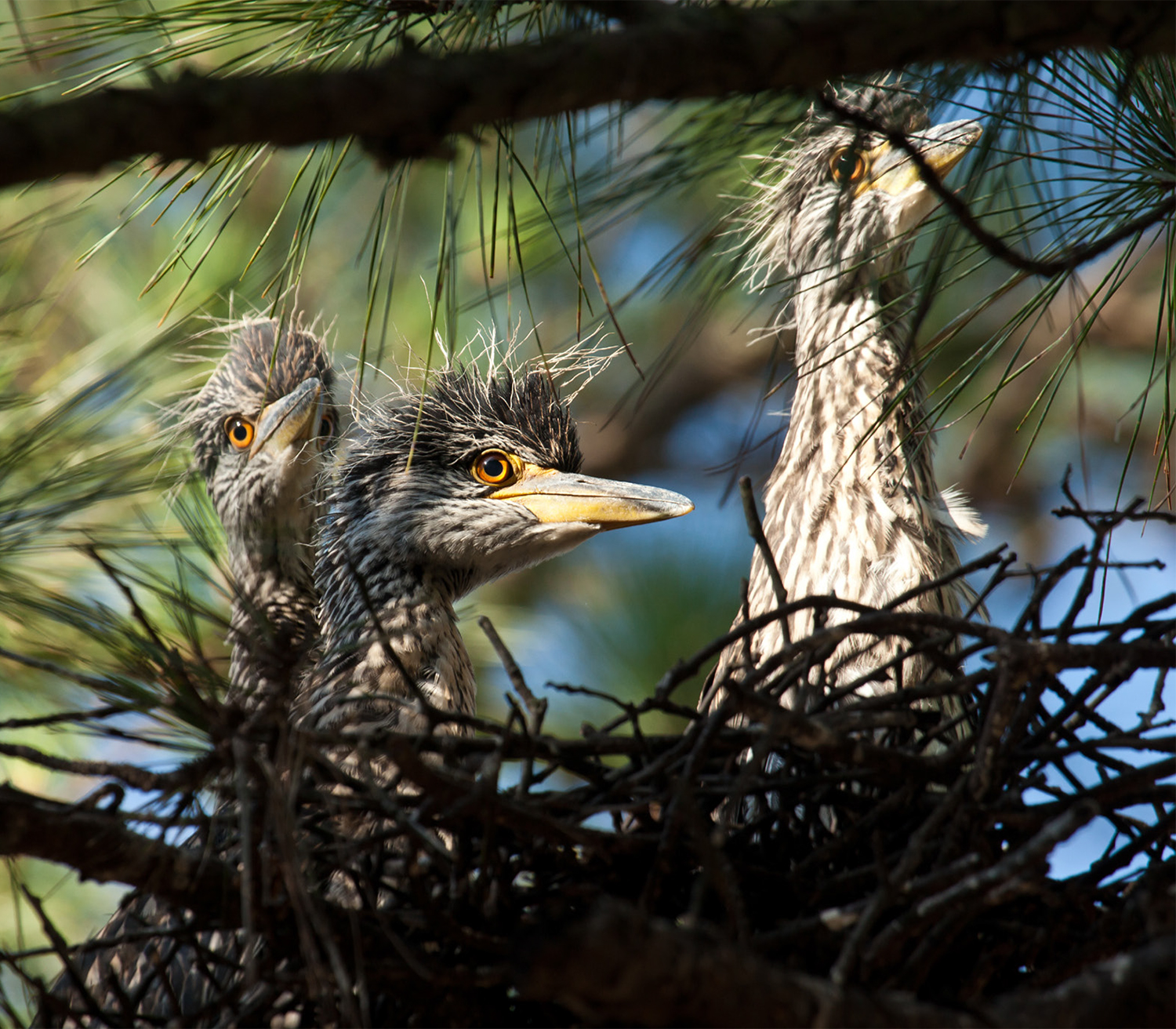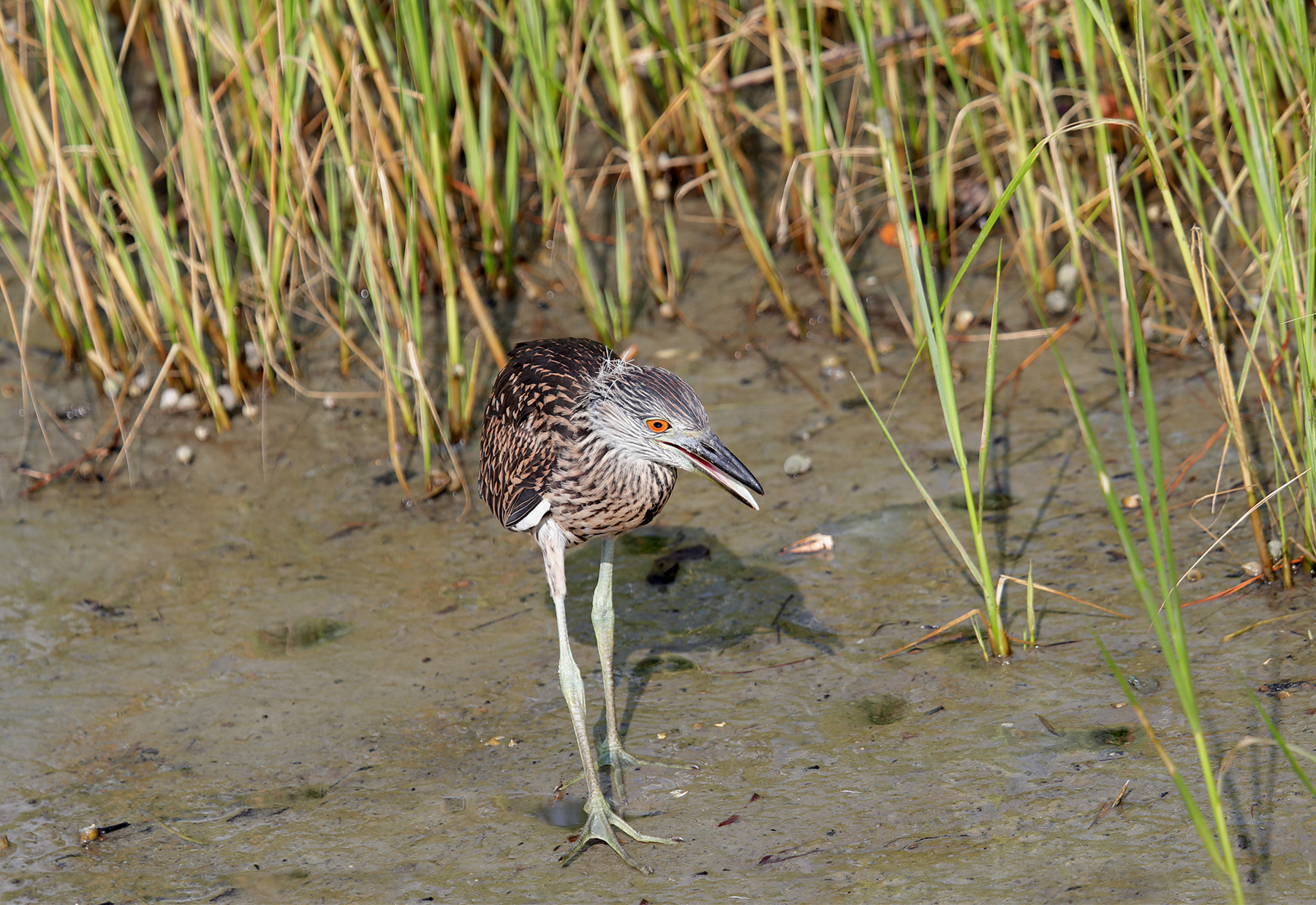Full Text
Thalia, it’s called, this upscale neighborhood in Virginia Beach that’s lined with red brick ranches shaded by tall loblolly pines. The community is a few short miles from the mouth of Chesapeake Bay and the Atlantic Ocean beyond. Bounded on the west by Thalia Creek and on the north by the eastern branch of the Lynnhaven River, Thalia is a magnet for human homeowners seeking proximity to water. It’s also become prime real estate for salt marsh-loving yellow-crowned night herons. And for the birds’ marsh-dwelling prey: mud fiddler, red-jointed fiddler, and white-fingered mud crabs.
|
|
Herons in the ’Hood
Like many other waterfront spots in the Virginia Beach-Newport News region, “almost every residence here has a yellow-crowned night heron nest in its loblolly pines,” says Bryan Watts, director of the Center for Conservation Biology, an organization that’s part of the College of William & Mary in Williamsburg and Virginia Commonwealth University in Richmond.
Watts is in the midst of a breeding season census of the herons and a look at the area’s fiddler crabs. The resulting data are the linchpin in a three-year study of the fiddlers’ and herons’ responses to the earlier start of spring. The project runs from 2015 through 2018, “but it really began more than 50 years ago,” says Watts, “with the work of the former first lady of Virginia, the late Constance DuPont Darden [1904–2002], who recorded yellow-crowneds’ comings and goings for more than a decade. She left behind an amazing data set on these birds and their prey.” Watts is comparing his observations with Darden’s from the 1960s.
Spring is coming sooner not only to the Virginia coast, but to the entire North American Coastal Plain, a region that stretches along the sea’s edge from Massachusetts to Texas. The North Atlantic Coastal Plain was recently named the world’s 36th biodiversity hotspot. “Sometimes something precious is right under your nose but goes unnoticed,” says coastal biologist Reed Noss of the University of Central Florida. “Such it is that a region long explored by botanists and zoologists was recognized only recently as a global biodiversity hotspot.”
In one corner of that hotspot, Virginia Beach’s Thalia, the loblollies shoot skyward, shading houses—and yellow-crowned night heron nests. “In full nuptial display, the yellow-crowned night heron is one of the most exquisite of all North American wading birds,” wrote A. Sprunt Jr. in a 1954 edition of Florida Birdlife. “Its soft grays and white crown and cheek patches seem to typify the elfin character of the cypress gloom.”
Although no cypress trees loom over Thalia, the loblolly canopy has the same darkening effect. As Watts wrote in a chapter on yellow-crowned night herons in the 2011 publication The Birds of North America, “Although occasionally breeding on coastal islands, this species most often inhabits forested wetlands, swamps, and bayous of the deep south where poor lighting seems to be the most reliable characteristic.”
On this day, “poor lighting” couldn’t be more welcome. It’s 7 a.m. in late July, but already temperatures are in the nineties. Watts and I make a loop around Thalia in his truck. We easily find heron nests. The splatters of whitewash below give them away. “Almost every homeowner has a nest on or near the property,” Watts says. With more than 30 nests, Thalia boasts the largest colony of yellow-crowned night herons in Virginia.
Some Thalia residents take issue with the herons’ presence “due to the ‘fouling’ of roofs and anything else that’s below the nests,” says Watts, “but most enjoy watching the birds raise their young.”
Yellow-crowned night herons frequently build nests in wooded neighborhoods with parklike appearances and open understories such as those beneath loblolly pines, Watts has found. In one study, 95% of 257 nests were in loblollies. Pines with a limb configuration in which the lowest limbs of the crown are horizontal seem to be preferred. “That usually translates to 40- to 70-year-old trees,” says Watts.
In Virginia, colonies in residential areas make up more than 80% of the yellow-crowned night heron population. “Pairs seem to prefer to set up housekeeping over rooftops, driveways and roads,” says Watts, leading to some interesting bird-human interactions. Cars parked beneath nests, for example, may be covered with shells from the birds’ fiddler crab meals.
A heron nest is usually placed away from a tree trunk on the outermost fork of a limb. I look straight up at a bundle of sticks above the corner of Dale and Thalia Roads and wonder why it doesn’t come crashing down. The nest’s three young herons, their bodies still more fuzz than feather, seem oblivious to the 15-meter plunge awaiting the merest misstep.
Flimsy as it is, the same “structure” may be used for years. Nests may last for an indefinite period without maintenance. “The human houses below should be as lucky,” says Watts.
|
|
Early Arrival—Of Spring and Herons
In 2015, the first year of Watts’ study, yellow-crowned night herons arrived and laid eggs more than 20 days earlier than pairs recorded in the same areas in the 1960s. In 2016 and 2017, the trend continued. The herons arrived and laid eggs a full week earlier, on average, than in 2015.
In the 1960s, the earliest Virginia Beach incubation time recorded was April 14. In 2015, it was March 23, and in 2016 a week before that. The 2017 timing was similar to that of 2015. “The birds are proving to be sensitive barometers of shifts in regional temperatures,” says Watts. In The Birds of North America, Watts wrote that early “on-eggs” records for the herons were March 24 in Florida, April 5 in Alabama, April 14 in Virginia, and April 30 in New York. What a difference a few decades make.
What’s driving the change in timing? There’s a clue in the Thalia neighborhood’s name.
Once upon a time, the locals say, Thalia was “swampland.” Indeed, the marsh plant Thalia, a genus of six species found in aquatic habitats, may have given the neighborhood its moniker.
|
|
Lure of the Fiddler Crab
Today the mucky marshlands that surround Thalia are home to innumerable fiddler crabs that roam over the mudflats, the males each waving a large claw in a fiddling motion to attract a mate, keep an intruder at bay, or ward off a predator. Fiddler crabs live in burrows in the mud, moving onto the flats to find food—bits of algae or decaying marsh plants—when the tide is low. In winter, fiddlers stay deep below the frost line in mud-covered burrows, then in spring emerge by the thousands…to the sight of long yellow-crowned night heron legs slowly stalking them across the mudflats.
All yellow-crowned night herons are crab-eaters first and foremost, feasting on crabs adapted to their specific locales.
Along the Atlantic Coast, says Watts, “the life of a yellow-crowned night heron is spent in pursuit of one thing: fiddler crabs.” The birds’ hunting times are scheduled around low tide when the crabs are accessible. The herons stalk fiddlers in salt marshes, “running them down on the mudflats,” says Watts. “Females gorge on fiddlers for the energy to produce eggs, and breeding pairs feed the crabs to their young.”
The yellow-crowned night heron is primarily a tropical species, “with four of the five living forms sedentary and confined to tropical latitudes,” Watts says. The Virginia yellow-crowneds are among the group that migrates north and south with the warm weather each year. The herons’ return in spring is tuned to their crab prey.
When the thermometer rises above 15°C (59°F), fiddlers emerge from their burrows and begin to scuttle across the mudflats. “The date in spring when the temperature passes the 15°C threshold is getting earlier,” says Watts, “extending the season of fiddler availability. Yellow-crowneds appear to be adjusting to that shift in season.
“We have no idea, however, how the birds are aware when the fiddlers are coming out. It’s a total mystery.”
Yellow-crowned night herons are so crab-dependent that more northerly populations, including herons in the Virginia Beach area, depart in the fall when fiddlers return to their burrows for the winter. That happens when the temperature drops below the 15°C threshold. Then the herons fly to subtropical and tropical latitudes where crabs are active year-round. Yellow-crowned night herons in the eastern United States join other snowbirds, heading to South Florida for the winter months.
In the cold season, as well as year-round for some yellow-crowned populations, the herons live in tropical and subtropical coastal regions along the US Gulf Coast, Mexico, Central America, the Caribbean, and South America as far south as Peru and Brazil.
For reasons that aren’t clear, yellow-crowneds began to extend their range northward in about 1925. The expansion seems to have leveled off in 1960 or so, although no one is sure. The birds are notoriously hard to track. They roost and nest in dark habitats, challenging biologists attempting to count them on foot or from aircraft.
The yellow-crowned night heron is rated a species of Least Concern by the International Union for Conservation of Nature (IUCN). “It has an extremely large range, the population trend appears to be stable, and the population size is very large, hence it does not approach the threshold for Vulnerable,” states the IUCN Red list assessment.
Could climate change affect the herons and their prey enough to shift that designation? It’s too early to tell, Watts says.
Where yellow-crowneds are faring well, the local crab population must be, too. Whether in Virginia, Florida, Peru or anywhere else, “the yellow-crowned night heron hunts using slow stalking movements,” wrote Watts in The Birds of North America. When it catches a large crab, he stated, “the bird methodically dismembers and eats it, body first.”
In the 1980s, Watts and colleagues conducted a study of the yellow-crowneds’ preferred meals. The scientists collected and identified more than 2,000 crab claws under nests, and found that three species—the mud fiddler, red-jointed fiddler, and white-fingered mud crab—made up 94% of the herons’ diet. The sand fiddler, ghost crab, blue crab, mole crab, toad crab and common mud crab accounted for the other 6%.
|
|
Doyenne of the Night Herons and Their Prey
Constance DuPont Darden knew that yellow-crowneds’ crab prey is found in the shallows of salt marshes and mudflats. A keen observer of the herons’ nesting and eating habits, Darden kept detailed records in the 1940s and again in the 1960s of the birds’ spring arrivals and fall departures in the Norfolk area. She wondered whether yellow-crowneds might be arriving earlier each spring and leaving later each fall, and what that inferred about their prey.
Darden, who married the late Colgate W. Darden Jr., Governor of Virginia from 1942 to 1946, carefully watched the herons from the couple’s Norfolk residence in Algonquin Park along Crab Creek, a tributary of the Lafayette River. In 1946, the first yellow-crowned nest appeared on their property. Later, a colony of the birds nested there.
For Connie, as she was known, the heronry became the site of hundreds of hours of birdwatching. “She took it up while her three children were still young,” remembers her daughter, Irene Darden-Field of Courtland, Virginia, an hour west of Norfolk. “She’d often go out before dawn to check on the herons, then be back in time to have breakfast on the table.”
Her careful recording of the birds’ habits, especially observations made in the 1960s, gave Watts the basis for his current study. “Darden’s invaluable data set is now housed at the Center for Conservation Biology,” he says.
In the May–June 1947 issue of The Raven, the journal of the Virginia Society of Ornithology, Darden wrote that “this heron remains in our coastal section from late March to early October. The first nest known to us was one found in our yard in Norfolk in the early stages of building on May 22, 1946, about 60 feet [18 meters] up in a [loblolly] pine tree a few paces from our porch. All books describe the yellow-crowned night heron as shy and retiring, but I have heard of four of our neighbors who have nests in their yards.”
Three of those nests, she wrote, were about 60 feet (18 meters) high, and all were built of sticks some 18 or 20 inches (46 to 51 centimeters) across. One nest, noted Darden, “was in my neighbor’s yard, which embraces the small growth of pines bordering a cove of Crab Creek. This creek is well named, for it contains an abundance of swimming and fiddler crabs, the latter making up a large part of the diet of these herons.”
The late ornithologist Witmer Stone of the Academy of Natural Sciences in Philadelphia had discovered that a quart of fiddler crab shells was often found beneath a yellow-crowned nest. But Darden made her own deductions. “My guess would be that at least three times that amount lay under our tree,” she reported.
Then Darden left Norfolk for more than a decade. She returned in the early 1960s and picked up her story of the herons.
“Not until April 14th did I think to keep a nesting record,” she wrote in the March 1962 issue of The Raven. “By that time there were already five occupied nests in three trees. The following day I found four more nests in progress; and the next, two more; likewise, two more on the 18th. That meant 13 nests established in four days. Later other nests were added, so a total of 19 were built during a month.”
Throughout the 1960s, Darden followed yellow-crowneds’ comings and goings.
“In closing,” she wrote in The Raven, “I shall report what I saw the afternoon of October 17th, 1960. A number of constant ‘quock’ cries brought me running out on our point. Several yellow-crowned night herons were circling the water round and round and one or two more joined them until there were six adult and two immature birds in the group. A laughing gull chased one of the birds and it flew into the marsh, but the others left together heading down the creek to the south. Apparently the start of the yellow-crowneds’ fall migration.” And a return to the muck for the fiddlers.
More than 50 years later, Bryan Watts hopes to answer Darden’s long-standing heron questions. It all comes down, he says, to the crabs.





